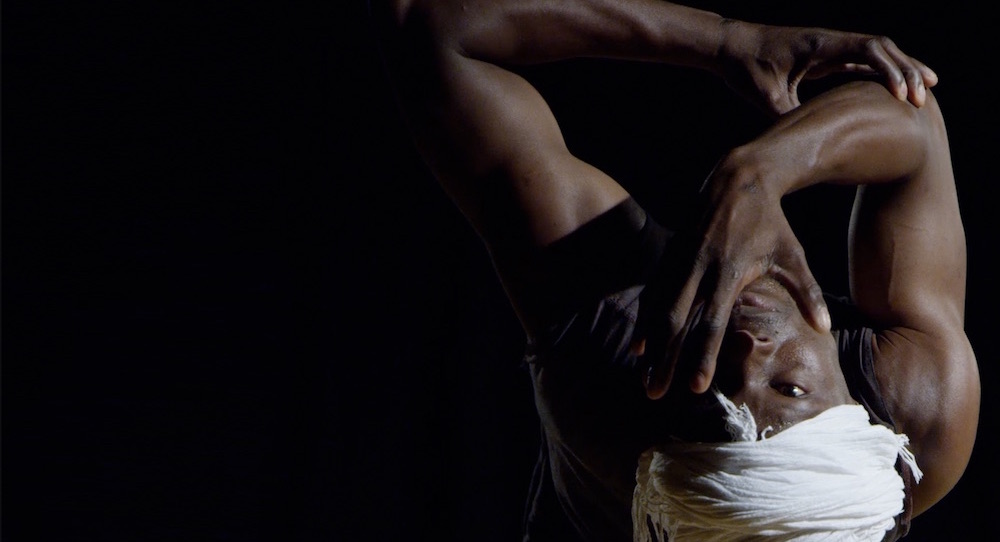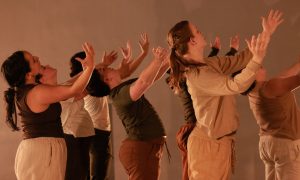Boston Center for the Arts, Boston, Massachusetts.
April 7, 2018.
Strictly speaking, there is unity and there is division. What if there could be unity even with difference, if difference didn’t have to mean division? Dance can probe such questions through use of oppositional and unison timing, as well as other choreographic tools and movement qualities. ANIKAYA Dance Theater’s Conference of the Birds explored these themes in such ways, along with aesthetically striking use of supporting technical elements and a conceptual base in a Persian tale of the performance’s namesake.
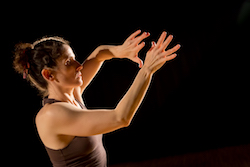
Wendy Jehlen. Photo by Melissa Blackall.
The company is under the direction of Boston-based dance artist Wendy Jehlen. Lights arose on dancers scattered throughout the space, some on platforms and the scaffolding that supported it. A sense of bird-like movement became clear, such as arms arching like wings and tiny flits of head and appendages.
These bird-like qualities were not overly literal, however, and truly unique to each dancer. Supporting that sense, they were not costumed like birds or even in the same color (which would have conveyed birds of the same kind in a flock). Each dancer had a solo not too long after the piece opened, which further illustrated their uniqueness as characters. Lighting and music created a different atmosphere around each solo – for instance, one ominous, one playful and one introspective.
They weren’t human, they weren’t avian; they just were. And beautifully so. A large part of what allowed this sense was how the movement took its time to breathe, seeming to not be at the whims of modern audience members’ patience levels and attention spans. Some audience members might find their mind wandering and feel an urge to check their phone (as undeniably compelling and beautiful everything was).
Others may find it refreshing, and perhaps even meditative, to take in the unapologetic pace of the layered unfolding action on stage. It seemed to alter my conception of time passing. In a post-show Q and A, one of the dancers introduced herself as a Butoh artist. Jehlen previously worked with her on a Butoh performance in Korea. I wondered if this was part of this quality of seeming to slow down time; the pace of the movement and action was nothing like that of Butoh, yet the attitude toward time and action in performance seemed at least akin to it.
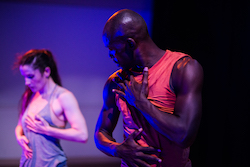
Wendy Jehlen and Lacina Coulibaly. Photo by Steve Wollkind.
Projection soon became another striking element, sometimes matching shifts of stage action. For instance, bird shapes flying every which way joined in flock – in the shape of a bird – at the same time as the dancers joined together. As if on a gust of wind, the bird shape dissipated into its parts of smaller birds. Another memorable instance of this was a bird conveyed in a curvilinear gold shape. As the wing-shapes lifted and tilted, so did the ensemble with arms in an elbows-lifted wing shape. They moved together as a unified whole, just as much as the projected shape was a unified whole.
All was not always harmonious, however. A couple of sections were memorable for their tension and turmoil. As one, a dancer began to shriek and convulse, as if in extreme agony. Some of the characters shied away in fear, and others froze. Still, others drew slightly closer in curiosity and perhaps desire to help. The rawness and authenticity of the moment pulled me right in. In another section, one dancer appeared intent on walking to the other side of the stage, yet other dancers walking toward her impeded that goal. With each occurence of this happening, her shoulders met another dancer’s, and she was unwillingly carried along his or her path for a few steps.
One by one, her desperation did not phase them; they kept on their path, expression blank and stone cold. Eventually, they came to lift her on their backs, leading into a new section of unison movement. The idea of conflicting objectives, and the question of whose will prevail in the face of that conflict, was loud and clear. In a similar section, another dancer tried to get past a row of dancers facing the back.The group put forth similar opposition but to a different maverick.
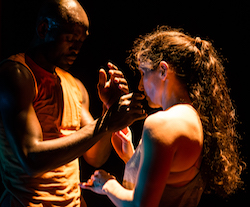
Lacina Coulibaly and Wendy Jehlen. Photo by Steve Wollkind.
In both cases, the group outweighed the one, until a way back to harmony emerged. It always somehow did. This message of unity prevailing become more even more overt in a section of voiceovers. People speaking in different languages spoke short phrases about shared humanity. Movement at this point supported this idea; dancers moved in their own individual phrases, yet in a similar speed and with a commonality that made the stage picture cohesive.
Individuality and commonality always came to co-exist. Throughout the performance, projection, sound, costuming and, above all, movement created these moments of clear harmony, tension and many things in between. The many dissolved into one, and the one back to many. In a time of increasing sociocultural and sociopolitical division, can we dissolve our differences – without erasing our individualities – and join into one? ANIKAYA Dance Theater’s Conference of the Birds certainly made me ponder the question.
By Kathryn Boland of Dance Informa.


